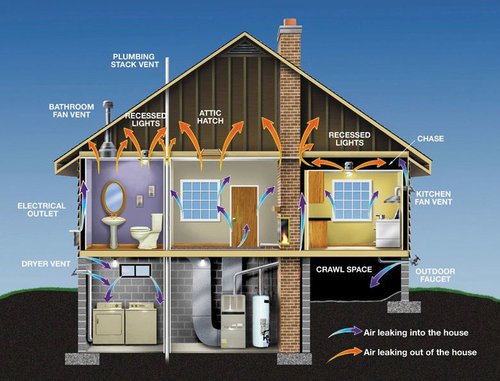How to save 25% or more on utility bills
How Air Sealing & Insulation Produces a 25% or Better Energy Savings in Homes
Some Quick Facts About most Homes Built Before 2014:
Typically leak over 60% of conditioned air inside to the outside.
Often 25% to 50% under-insulated in order to be energy efficient.
Leak over 20% to 30% or more of the air inside ductwork.
Most homes are built with builder grade (low performance) windows, doors, heating, air-conditioning, and water heating equipment.
What do these facts mean?
Homes built before 2012 IECC (International Energy Conservation Code) which were not practiced on wholesale level until 2014 in many areas, were built to far lower energy performance codes than those after 2014. These outdated codes included code-minimum insulation practices, as well as not providing any code compliance for critical energy saving methods such as structural air sealing, duct sealing, Energy Star compliant windows and doors or high efficiency heating, cooling or water heating equipment.
These factors combined, produced homes which on aggregate could easily be over spending 25% to 50% or more on electricity and natural gas utilities. Of all energy saving improvements, it has long been regarded by the U.S. Department of Energy, AIA, BPI, USGBC and other energy conservation entities that critical structural air sealing and insulating beyond basic building code (pre 2014) are the most important first steps to energy conservation as they are structural in nature. Critical structural air sealing and insulating to Energy Star or better levels (R-50+ for the Midwest region) produce the largest combined impact on energy use and waste.
Where Air Leaks, So money goes
Common air leaks for homes where outside air can infiltrate, and conditioned air can escape.
Most (pre 2014) homes leak over 50% of their structural air to the outside. This means that the home has to recondition its inside air many times each day placing a significant load on heating and cooling systems and driving up energy costs.
According to the Department of Energy, Berkeley Laboratories, and independent field data, even a 20% reduction in air loss combined with insulation meeting or exceeding the R-49 Energy Star recommendation for the Midwest region, can easily result in a 25% to 50% or more reduction in energy use, depending on the severity of air loss and the type, condition, R-Value and installation quality of the insulation installed in the home.
While every home is different, generally air sealing and insulating the home first have the highest return-on-investment when compared to other energy saving improvements such as replacement windows and doors, or furnace and airconditioning upgrades. Deep structural air sealing (pictured at right) minimizes air loss and helps the home maintain temperature, thus lowering the amount of energy needed to maintain desired interior temperatures.
Attic Insulation - The Builder Grade "Status Quo"
Often attic insulation is treated as a “necessary evil” in the building process. Many homes attic insulation was installed to low building code standards (pre 2014), not installed properly and often utilized the least expensive, low performance materials. In addition to low installation standards and materials, CONDITION impacts insulation performance. Many older homes have attic conditions which further compromise the R-Value performance of the insulation such as settling, material movement, attic debris, rodent infestation and more.
Air Sealing and Attic Insulation - The Critical “One-Two Punch”
Attic air sealing involves using the right materials and techniques to properly air seal all air leaking structural features. These include:
Wall top plates
Open chase ways
Wiring, plumbing, HVAC penetrations
Bathroom vent fans
Attic fans
Attic hatches
Additional structural air sealing could include:
Windows & Doors
Basement rim joist
Crawlspaces
Insulating to High Performance Standards
Most homes attic insulation is comprised of blown-in fiberglass or cellulose insulation. It was typically installed to a bare minimum standard with less regard for the finished product than meeting a building budget or production schedule. Retrofit insulation practices on the other hand are services designed to maximize the impact of air sealing and insulating. Retrofit insulation services take attic insulation to Energy Star standards and beyond (R-49) and/or use higher performance materials like spray foam insulation.
One Plus One Does Not Equal Two
An attic insulated to R-30 in 1990 may be performing like R-20 to R-25 today due to material movement, settling, debris or other conditions present in the attic. Insulating that same attic (after air sealing) to R-55 is a minimum 100% improvement in R-Value. When combined with air sealing which is measured to produce a minimum 25% reduction in air flow (loss), these two factors combine to create a high performance structure which is a minimum 25% more air tight and 100% or more better insulated to hold temperature. When combined, these two practices easily produce energy saving results of 20% to 50% or more depending on the CONDITIONS in the home.
Standards Matter
Air sealing and insulating to high performance levels are not the practice of most insulators. To achieve results mentioned here, processes must follow higher energy efficiency codes and standards of practice such as Home Performance with Energy Star and Building Performance Institute (BPI).

